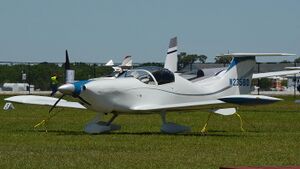Engineering:Alvarez Polliwagen
| Polliwagen | |
|---|---|

| |
| Role | Homebuilt aircraft |
| Designer | Joseph Alvarez |
The Alvarez Polliwagen is a 1970s homebuilt aircraft. The aircraft has a combination of many high performance features not typically found in a Volkswagen air-cooled engine-powered homebuilt.[1]
Design and development
The Polliwagen is a low wing, side-by-side configuration, T tailed, retractable tricycle landing gear equipped aircraft with tip tanks. The aircraft was developed and tested with a one quarter scale radio controlled model.[2] Ailerons and flaps are full span. The fuselage is built from composites with foam cores. The aircraft's engine is configured with a turbocharger and constant speed propeller.[3] Entrance is through a swing up canopy.[4]
Specifications (Polliwagen)
Data from Plane and Pilot
General characteristics
- Crew: 1
- Capacity: 1 passenger
- Length: 16 ft (4.9 m)
- Wingspan: 26 ft (7.9 m)
- Airfoil: Wortmann FX-67-K-150
- Empty weight: 600 lb (272 kg)
- Gross weight: 1,250 lb (567 kg)
- Fuel capacity: 19 U.S. gallons (72 L; 16 imp gal)
- Powerplant: 1 × Lycoming o-235] horizontally opposed piston, 78 hp (58 kW)
- Propellers: 3-bladed ground adjustable Warp drive
Performance
- Maximum speed: 220 kn (250 mph, 400 km/h)
- Cruise speed: 160 kn (180 mph, 290 km/h)
- Stall speed: 33 kn (38 mph, 61 km/h)
- Range: 1,000 nmi (1,200 mi, 1,900 km)
- Service ceiling: 28,800 ft (8,800 m)
See also
Aircraft of comparable role, configuration and era
- Colomban MC-100
- Dyn'Aéro MCR01
- Lancair 320
References
- ↑ David E. Pullmann. Acceptance of Mediocrity. p. 197.
- ↑ "none". Flight International. 22 August 1977.
- ↑ "Polliwagen". http://www.planeandpilotmag.com/aircraft/international-aircraft-directory/homebuiltkitbuilt-aircraft/polliwagen.html. Retrieved 2 December 2013.
- ↑ "none". Popular Mechanics: 77. January 1980.
 |

